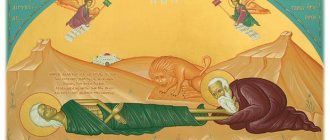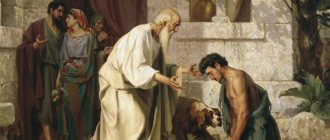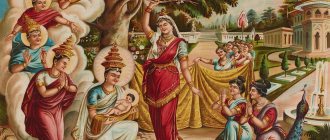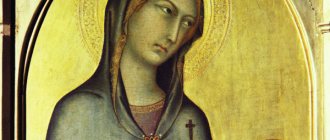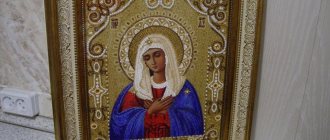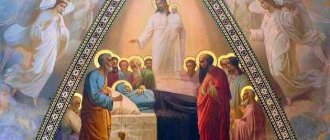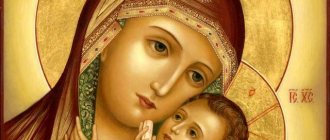Christ went to preach in different cities and villages and performed miracles everywhere and carried the Word of God. People saw that he was truly the Son of God and followed him.
The Gospels are filled with stories about such people. So were the sisters Martha and Mary.
During his wanderings, Christ stopped with two sisters, Martha and Mary
See also the articles The Gospel of Mary
Information about the sisters is found in the Gospels of Luke and John
The full parable of Martha and Mary goes like this:
Continuing their journey, He came to a certain village; here a woman named Martha received Him into her home; she had a sister named Mary, who sat at the feet of Jesus and listened to His word.
Martha was taking care of a great treat and, approaching, said: Lord! or do you not need that my sister left me alone to serve? tell her to help me.
Jesus answered and said to her: Martha! Marfa! you care and fuss about many things, but only one thing is needed; Mary chose the good part, which will not be taken away from her.
(Luke 10:38-42)
The Bible is filled with parables that need to be interpreted correctly.
Christ told Martha and Mary about the salvation of the soul
The episode is usually interpreted as follows:
Continuing their journey, He came to a certain village; here a woman named Martha received Him into her home...
Martha accepted Christ. She was the main one in the house: either the mistress or the eldest in the family. She received him along with his disciples: Christ walked everywhere with them.
What is not said about them in the parable should not worry: Jesus, as the Son of God, was the main one and the main attention was paid to him.
Martha accepted Christ as a stranger, because He had no place to live, preached throughout Palestine and ate alms.
...she had a sister named Mary, who sat at the feet of Jesus and listened to His word.
Jesus entered the house and began preaching. The third character of the parable appears in the story - Martha's sister Mary.
Martha continues to act as the eldest in the house. She needs to feed the company that came. But she does this alone: Mary listens to Christ, turning her ears and thoughts to his speeches and does not want to miss a single word from the Divine Revelation.
Martha was taking care of a great treat and, approaching, said: Lord! or do you not need that my sister left me alone to serve? tell her to help me.
Marfa is frankly not coping. The duty of hospitality obliges her to please the guests, but one pair of hands is not enough, especially since she wants to serve the strangers a “great treat.” She needs the help of a sister who sits and listens to Jesus.
Martha asks Christ to influence the “unlucky” sister.
A contradiction arises: on the one hand, very necessary, but mundane matters. On the other hand, you can miss the words of the teacher and thus not come to salvation.
Two sisters express love to Christ, but in different ways: Martha - by fulfilling the duty of hospitality, Mary - by attention to his teaching. This is what Christ says:
Jesus answered and said to her: Martha! Marfa! you care and fuss about many things, but only one thing is needed; Mary chose the good part, which will not be taken away from her...
The contrast between the worldly and the spiritual will be included in the Sermon on the Mount: one cannot serve equally two masters, God and mammon, i.e.
It is impossible to engage in both spiritual and worldly matters with the same diligence. Christ is grateful to Martha, but draws her attention to the other, spiritual side of the matter, instructs her on the path to the Highest Good. In the Sermon on the Mount He will say:
Seek first the Kingdom of God and His righteousness, and all these things will be added to you.
(Matt. 6:33)
And further:
...what will it profit a man if he gains the whole world and loses his own soul?
(Matt. 16:26)
Thus, Christ teaches that we should heed his teaching and seek first of all the salvation of our immortal soul.
However, you shouldn’t think that you can give up everything and do nothing. You shouldn’t think about the material at the expense of the spiritual, but you shouldn’t forget your responsibilities towards loved ones, work, and affairs.
What does Church Tradition say about Mary Magdalene?
All Christians know the story of how, several years after the Ascension of the Lord, Mary visited the Roman Emperor Tiberius (Tiberius ruled the Roman Empire until 37 AD. This means that if we assume that Christ was crucified and resurrected around the year 30 (given that he was born He in 5–6 BC), Mary Magdalene had about six and a half years left to travel to Rome), informed him of the Resurrection of Christ and presented him with a modest gift - an egg. The emperor laughed: “A dead person cannot be resurrected, just as this egg cannot turn from white to red,” and then the egg in his hand turned red. Which, however, did not convince the pagan emperor (according to other sources, Tiberius, on the contrary, believed and punished Pilate, Anna and Caiaphas who crucified Christ).
Saint Mary Magdalene.
19th century icon. Mary Magdalene is depicted holding the reliquary as a sign that she is one of the myrrh-bearing women. But this story is of very late origin: apparently, it first appears in the apocrypha (Apocrypha (from the Greek “secret, hidden”) are books that “supplement” or “continuing" the Holy Scriptures, telling about events associated with biblical heroes, but not mentioned in the Bible. The Church as a whole does not consider the apocrypha to be any reliable and authoritative sources, although there is some information from individual apocryphal books - for example, about the Nativity of the Virgin Mary, about Her introduction into the temple, about Her Dormition - accepted into her Tradition.) “Tiberius’s answer to Pilate” (X-XI centuries). In this text, the authenticity of which raises serious doubts among experts, Tiberius responds to Pilate’s report about the execution of the Galilean Jesus and reports that Mary Magdalene came to him and testified about the miraculous Resurrection of the Crucified One. Even later, Mary’s journey to the Roman emperor was reported by the author of her Latin life (XII century), Byzantine historians George Kedrin (the turn of the XI and XII centuries) and Nikephoros Callistus Xanthopulus (XIV century). Almost no early Christian evidence of Mary Magdalene, with the exception of the Gospel, has survived. The only one who mentions it in the second half of the 2nd century is the Roman philosopher Celsus, an implacable enemy of Christians. And among the Christian stories that have come down to us about Mary Magdalene, the earliest is the “Word on the Myrrh-Bearing Women” by St. Modest, Patriarch of Jerusalem (7th century). Two centuries later, this text (in a brief paraphrase) was included in the “Library” of St. Photius, Patriarch of Constantinople. There is not a word about Mary’s journey to Rome, but it is said that she was in the service of the Most Holy Theotokos, and after Her Dormition she went to Ephesus (a large city in Asia Minor, now Turkey), where a large Christian community was led by the Apostle John the Theologian. This “Word” also mentions the martyrdom of Saint Mary: before her death she was tortured, and during the torture she suddenly transformed, so that her body seemed to her tormentors like a sparkling crystal. Information about the ministry and preaching of Mary Magdalene in Ephesus was also preserved in other Byzantine monuments of the late 1st - early 2nd millennium AD. In her short life, which was included in the synaxarion (Sinaksarion - from the Greek Συναξάριον, “collection” - a collection of excerpts from patristic writings and lives of saints, which were previously read during the morning service, after the sixth song of the canon) of the Church of Constantinople (end of the 10th century) it is said that Mary Magdalene “reposed in a venerable manner” in Ephesus and was buried at the entrance to the cave of the Seven Youths of Ephesus (obviously, even before the miracle happened to the youths themselves, who lived and died in the 3rd century). Approximately 100 years before the composition of this life, the relics of Saint Mary Equal to the Apostles were transferred by order of the Byzantine emperor Leo VI the Wise (866–912) from Ephesus to the Constantinople monastery of righteous Lazarus. However, the Russian abbot Daniel, the author of the famous “Walk” to the Holy Land (1106–1108), reported that at that time the tomb of Mary Magdalene in Ephesus was still revered, and the venerable head of the saint was even preserved there. According to Nicephorus Callistus Xanthopoulus (14th century), the evangelistic works of Mary Magdalene were not limited to Palestine and Ephesus. According to this Byzantine historian, she preached throughout Italy and Gaul (the territory covering the north of present-day Italy, all of France and southwest Germany), visited Egypt, Phenicia, Syria, Pamphylia (the southern province of Asia Minor, now part of Turkey) . Even later, in the 15th–16th centuries, the life of Mary Magdalene acquired new details. A legend arises that upon returning from Rome to Jerusalem, the saint worked for some time together with the Apostle Peter (and, perhaps, was even present at his execution in Rome), and 14 years after the Ascension of Christ, she became an assistant to the Apostle “from seventy” Maximus. One day, the Jews captured Maximus, Mary Magdalene and several other Christians, put them on an uncontrollable ship and left them at the mercy of the wind and sea waves. The waves brought the ship to Massilia (now the French city of Marseille), where the local ruler believed in Christ after his wife, through the prayer of Mary Magdalene, became pregnant. According to this version of her life, Saint Mary went to Ephesus already in adulthood, anticipating her imminent death. The Life, compiled on Mount Athos, names Palestine as the place of martyrdom of Mary Magdalene. The Jews subjected her to cruel torture, but at the moment of the highest suffering, Mary’s body sparkled like crystal - then the torturers got scared and put her, along with other disciples and disciples of Christ, in an uncontrollable boat and put her into the sea.
Martha and Mary - sisters of Lazarus resurrected by Christ
One of Christ’s miracles was the resurrection of Lazarus from Bethany, the brother of Martha and Mary.
The Gospel of Luke tells only the parable itself about Martha and Mary. Chapters 11 and 12 of the Gospel of John tell us a little more about the lives of the sisters. Chapter 11 describes to us the resurrection of Lazarus. The first verse mentions the sisters:
A certain Lazarus was sick from Bethany, from the village where Mary and Martha, her sister, lived...
(John 11:1)
Lazarus dies. Christ knows about this and goes to Bethany. They meet him there:
Martha, hearing that Jesus was coming, went to meet Him; Maria was sitting at home.
Then Martha said to Jesus: Lord! If you had been here, my brother would not have died.
But even now I know that whatever you ask from God, God will give you.
Jesus says to her: Your brother will rise again. Martha said to Him: I know that He will rise again on the resurrection, on the last day.
Jesus said to her: I am the resurrection and the life; He who believes in Me, even if he dies, will live. And everyone who lives and believes in Me will never die.
Do you believe this?
She says to Him: Yes, Lord! I believe that You are the Christ, the Son of God, coming into the world. Having said this, she went and secretly called Mary, her sister, saying: The Teacher is here and is calling you.
She, as soon as she heard it, quickly got up and went to Him.
(John 11:20-29)
Bethany is the village where Christ stopped before entering Jerusalem. It is clear from the text that Jesus visited there more than once. He has known all three for a long time:
Jesus loved Martha and her sister and Lazarus...
(John 11:5)
Bethany is identified with the city of Al-Azaria, where the tomb of Lazarus is located.
Then many of the Jews who came to Mary and saw what Jesus had done believed in Him (John 11:45)
After the resurrection of Lazarus in front of the sisters, the Jews, led by the high priest Caiaphas, finally decided to kill Jesus.
Christ resurrects Lazarus, and, fearing persecution from the Jews, goes into the desert, to the city of Ephraim. But he will return to his sisters in Bethany.
Righteous Mary of Bethany, sister of Lazarus of the Fourth Day
Kontakion 1
Chosen by God as servants of new grace, righteous Lazarus, God-loving sisters, Martha and Mary, you followed Christ in your deeds and minds in faith and love, and now you abide with the faces of the holy women, enjoying the beauty and joy of heaven. Moreover, as those who have boldness towards the Lord, diligently pray to Him to deliver us from the troubles and sorrows and falls of sin, so that having learned to please Christ our God, we may not cease to cry out to Him with tenderness: Alleluia!
Ikos 1
The King and Lord of angels and man, having foreseen the kindness of your souls and loved you to the end, during the days of His earthly life you visited your blessed house and raised your brother Lazarus from the dead. We are sinners, remembering His philanthropic condescension, in the tenderness of our hearts we cry out to you like this:
Rejoice, having loved God with all your heart, with all your soul and with all your thoughts;
Rejoice, your love was not shown in word or tongue, but in deed and truth.
Rejoice, having received love for faith in Christ, the Son of God, from the Heavenly Father;
Rejoice in faith, obedience, deeds of love and mercy, having served Him.
Rejoice, you who have inherited the Kingdom of Heaven;
Rejoice, praise and adornment of chaste virgins and chaste women.
Rejoice, Marfo and Mary, for showing us an image of faith and love.
Kontakion 2
Knowing, righteous women, that the Lord, who has no place to bow his head, will come to you, they labored in His house, as the Divine teacher, to listen with faith and love, and with zeal to serve Him to many. In the same way, you teach us to serve Him, as God, who became incarnate for our sake, without laziness and reverently chant: Alleluia.
Ikos 2
Teaching us not to give up our love of hobbies, and to be diligently diligent about the word of God, not on bread alone will man live, but on every word of God, our Lord and Teacher and the industrious service of Martha did not abandon, and Mary’s seat at His feet was greatly blessed. In the same way, we will sing to this God-loving duo:
Rejoice, Marfo, Christ, for the sake of us who became incarnate, who welcomed us into your house;
Rejoice, not rejected in your service to the needs of His flesh.
Rejoice, teaching us to serve Him through works of mercy;
Rejoice, Mary, who was satisfied at the feet of Jesus with the word of His mouth.
Rejoice, thou who hast chosen only one thing for need, as the good part;
Rejoice, you who are numbered with His blessed ones for the sake of zeal for hearing the words of the Lord.
Rejoice, Marfo and Mary, for showing us an image of faith and love.
Kontakion 3
We were strengthened by the Divine power, we were not hurt by despondency, when we saw your brother being exhausted by a cruel illness, but we sent with hope to the Healer of ailments, the Lord Jesus, saying: Lord, he who loves him is in pain. This follows, and let us not give in to despondency in any situation, but with hope in Christ our God crying out: Alleluia!
Ikos 3
Jesus loved Martha and her sister and Lazarus and, testing and confirming their faith in the coming Kingdom of eternal life, said: this illness does not lead to death, but to the glory of God, that the Son of God may be glorified for her sake. But you, oh, God-loving sisters, even in the face of the death of your brother, with faith and love for Christ in your spirit, burning, did not doubt His Divine power. For this reason, accept the following praise from us:
Rejoice, you have not fallen into hopeless despondency and sorrow;
Rejoice, for those who are burdened with the sorrows of everyday life find encouragement.
Rejoice, in your sorrow you turned your thoughts to the Physician of souls and bodies, the Lord Jesus;
Rejoice, you who have not seen His face, have remained in good submission to Him.
Rejoice, for in this trial you showed strong faith, like Abraham’s;
Rejoice, you have steadfast patience in the face of suffering, like Job who showed it.
Rejoice, Marfo and Mary, for showing us an image of faith and love.
Kontakion 4
Knowing what the Almighty Lord and our Savior wants to do, He spoke to His disciple: Lazarus, our friend, has succeeded. But I go and excite him; teaching everyone to walk in the light of the face of God and to sing to the Giver of life: Alleluia!
Ikos 4
Many Jews came to Martha and Mary, that they might be comforted about Lazarus their brother. The sisters ran away from them, as if they had no hope in Christ Jesus. Martha directed her steps with joy to the One Comforter, when she reached that Bethany. Let us sing to them with such strong love of the Lazarev sisters for Christ and their faith, with joyful voices:
Rejoice, you were able to conquer the stony hearts of your unfaithful Jews with the kindness of their souls;
Rejoice, not in vain despondency, but in surrendering yourself to God’s favor.
Rejoice, having placed your hope in the sole goodness of Christ in your sorrow;
Rejoice, having directed your steps with diligence to meet Him.
Rejoice, in your hope from Him who is able to save the justified;
Rejoice, for consolation in sorrows does not come from people, but from God, teaching us.
Rejoice, Marfo and Mary, for showing us an image of faith and love.
Kontakion 5
Blessed Martha, when you see the Lord, seeking consolation from Him, says: Lord, if You were here, my brother would not have died. But even now we know that if you ask for anything from God, God will give it to you. To him with all our souls we cry: Alleluia!
Ikos 5
Showing His divine view of our salvation, Lord Jesus, as the Master of life and death, deign to say to you, blessed Martha: your brother will rise again. And again: believe in Me, even if you die, you will live. Do you believe this? - ask you. You answered Him: I believe, Lord, that You are the Christ, the Son of God, coming into the world. For this reason, through the faith in Christ the Son of God taught by you, we praise you:
Rejoice, blessed Martha, who heard the promise of the resurrection of your brother from Himself the Giver of Life;
Rejoice, for having been asked by Him about your faith, not flesh and blood, but having listened to the voice of the Heavenly Father.
Rejoice, for having been taught from Him, you firmly confessed Christ the Son of God;
Rejoice, for this is the stone of faith, on which the Lord created His Church, which has manifested itself.
Rejoice, in your confession you became like Peter the Supreme Apostle;
Rejoice, truly worthy of Equal-to-the-Apostles blessing.
Rejoice, Marfo and Mary, for showing us an image of faith and love.
Kontakion 6
Do not break a bruised reed, O Lord, lover of mankind, when you saw Mary and the Jews who came with her weeping, as they loved Lazarus, you yourself shed tears. Yes, and we, weak and in sorrow, fearlessly flow to Him with tears, crying out to Him: Alleluia!
Ikos 6
Truly blessed is your cry for your brother, Mary, when Jesus saw him shed tears. For this reason, with tenderness, we please you:
Rejoice, God-loving Mary, who did not extinguish your love for the Lord in your seraphic love for your relatives;
Rejoice, we weep for you for Lazarus, who were in the petrification of our hearts and exposed us.
Rejoice, you who made Christ God shed tears for His fallen creation;
Rejoice, in the tears of the Lord Jesus, who sympathized with our weaknesses, who showed the oil of consolation to all those who cry and are sick.
Rejoice, you who are able to show compassion for us in our sorrows;
Rejoice, with your sister Martha, the first God-pleasing leader of mercy to the sisters.
Rejoice, Marfo and Mary, for showing us an image of faith and love.
Kontakion 7
Omniscient in His Divinity, showing human nature, asked about Lazarus, Lord Jesus: where they laid him. And he commanded that the stone be taken from the tomb, so that the lips of the unfaithful would be blocked by the sting of death. We, faithful, with boldness to You, overcome death to the One who came, crying out: Alleluia!
Ikos 7
Showing the weakness of human nature, the sister of the deceased, Martha, said to Jesus: Lord, it already stinks: for it is four-dayed. Mary, seeing the stone rolled away from the tomb, remained in silence. Listening to this silence of Mary with tenderness, and with Martha boldly confessing our lack of faith in the Lord, let us cry out to them like this:
Rejoice, Mary, for you who came to the stinking tomb in trembling silence for Christ;
Rejoice, for in this way you taught us all to conquer the mind in obedience to faith.
Rejoice, Marfo, for you teach us to overcome the weakness of our faith;
Rejoice, for all of us: I believe in her, Lord, for You are the Christ, the Son of God, as you said.
Rejoice, blessed sisters, in the weakness of your souls and bodies, you did not depart from Christ and followed His love;
Rejoice, raised to the height of grace-filled understanding by the Omniscient Himself.
Rejoice, Martha and Mary, who show us the image of faith and love.
Kontakion 8
Having revealed His glory as the Only Begotten from the Father, having given glory to His Father to all the faithful, Jesus cried out with a great voice: Lazarus, come out. And the lifeless one, having listened to the One who gives breath, rose from death and came from the grave; Yes, this miracle is visible, abundant, and we will sing to the Conqueror of Death: Alleluia!
Ikos 8
Christ our God performed a great and terrible miracle, raising Lazarus of the four days from the dead. Yes, and He will confirm our faith in Him as the Son of God, assuring us of the immortality of the soul and the general resurrection of all. We, who repay divine worship to the Creator of this, will please the sisters of Him resurrected and cry out to them:
Rejoice, sister of righteous Lazarus, who loved Christ unfeignedly;
Rejoice in Christ for the faithfulness of your beloved.
Rejoice, having seen the general resurrection before the passion of Christ in faith;
Rejoice, for through your faith you strengthen our faith.
Rejoice, glorious disciples of Christ;
Rejoice, O face of the Apostolic true communicant.
Rejoice, Marfo and Mary, for showing us an image of faith and love.
Kontakion 9
The sons of darkness, who died in vain and rose from corruption by the voice of God, in the hardness of their hearts did not believe in Christ even to this day, in the blindness of existence. We, who are not attached to this madness, but believe in the general Resurrection according to the voice of the Son of God, to Him, as the Giver of Life, let us loudly and with all our souls cry out: Alleluia!
Ikos 9
Having created the glorious and terrible thing in Bethany, Jesus, before the six days of Passover, came again at this whole time. And you made supper for Him, and Lazarus was alone from those who sat with Him. But you, ever-blessed sisters, give thanks to the Giver of all things, Martha serving Him with all diligence, and Mary the ointment on the nose of His libations. For this reason, we wish to bring you into your joy, and we call to you with tenderness:
Rejoice, God-wise woman, filled with praise and thanksgiving to the beneficent Lord;
Rejoice, hardworking Martha, who served the Lord at supper once again.
Rejoice, thou graciously accepted by this Lord in grateful service;
Rejoice, Mary, who anointed the Sweetest Jesus with precious myrrh.
Rejoice, in denouncing the blasphemies of Judas you have been honored with the praise of Jesus;
Rejoice, for you have poured a drink offering on the nose of Christ with this valuable ointment, and you have taught us the beauty of the house of God and are diligent in teaching us about this.
Rejoice, Marfo and Mary, for showing us an image of faith and love.
Kontakion 10
Let us faithfully imitate Martha and Mary, each in our rank, fall before Christ the Savior and, asking for His healing of our infirmities and from the sleep of sinful resurrection, let us sing to Him with grateful lips: Alleluia!
Ikos 10
Faithful to the end in your service to Christ in the days of His flesh, and witnesses of the passions of His existence, those who were deemed worthy to witness the burial of the Resurreator of Lazarus, the glorious Martha and Mary, appeared in the midst of the myrrh-bearing women. With them now stands before the throne of the glory of God, with your prayers to that hymn-filled face join us too, glorifying your exploits:
Rejoice, Marfo, in your many-serving service to Christ, just as in your confession, you were jealous;
Rejoice, hero of heroism to hosts of strangers and sisters of mercy.
Rejoice, Mary, beloved disciple of Christ John, who in ardent love became like Him;
Rejoice, immaculate virgins, who were ignorant of Christ in their lives, not a false guide.
Rejoice, God-loving sisters, who are quite zealous for Christ through their active life and attentive study of the heart;
Rejoice, on both of these paths of pleasing the Lord to live, the brethren together teach us wisely.
Rejoice, Marfo and Mary, for showing us an image of faith and love.
Kontakion 11
Which verb is sufficient to sing the universal joy of the Resurrection of Christ, even if you, with the other myrrh-bearing women, received communion on this great and holy day; Likewise, we, the Resurrection of Christ, glorifying the majesty of God, sing to Christ: Alleluia!
Ikos 11
Those who pray pass away every temptation and want to overcome the eternal belly, as faithful disciples of Christ, each in their own way, having worked for Him with the same spirit of faith and love, they were granted joys in His Kingdom. For this reason, remembering your labors and exploits and rejoicing in your glory in the Kingdom of Christ, we sing to you this:
Rejoice, faithful disciples of Christ, for having pleased not men, but God in your life;
Rejoice, having acquired the Kingdom of Heaven through spiritual poverty.
Rejoice, you who have inherited the land of promise with a spirit of meekness;
Rejoice, having been granted mercy by deeds of mercy from the Lord in His Kingdom.
Rejoice, seeing with a pure heart the Word of God;
Rejoice, confessors of the faith of Christ, who have received much reward in heaven.
Rejoice, Marfo and Mary, for showing us an image of faith and love.
Kontakion 12
By the grace of the All-Merciful God, you received great boldness towards Him, oh blessed sisters. Bring up your prayers and petitions for us sinners to the throne of His glory, so that we may be saved by your intercession, the Risen One who resurrected everything with Himself and sing the angelic song: Alleluia!
Ikos 12
Singing now with all the heavenly powers the Trisagion hymn to the wondrous God in His saints, O blessed sisters of Lazarus, look down from the heights of heaven upon us sinners, overwhelmed by the waves of the sea of life, thirsting for a quiet refuge and magnifying you with love:
Rejoice, in heaven in glory with the Angels and all the reigning saints;
Rejoice, also on earth, in the Church of Christ, glorified in song.
Rejoice, as the stars of heaven shine in the darkness of this age with your virtues;
Rejoice, teachers given to us by God in our life.
Rejoice, first merciful servant of Christ;
Rejoice, prayer books warm for us to God.
Rejoice, Marfo and Mary, for showing us an image of faith and love.
Kontakion 13
Oh, devoted God-loving duo, faithful disciples of Christ, the glorious Martha and Mary, who kindled the fire of love and faith in your souls and for these sake entered into the Kingdom of glory by the power of the Risen One, ask Christ our God for help in your ways to live here on earth and in the monastery The Heavenly Father, who has taken residence, together with you and all the saints, and we, on the throne of glory who sits, will sing the angelic song: Alleluia!
(This kontakion is read three times, and then ikos 1 and kontakion 1)
Prayer 1
Oh, holy and all-praised disciples of Christ, God-loving Martha and Mary! Pray to the Sweetest Jesus, whom you have loved and loved, Whom you have confessed as Christ, the Son of God, that He may also grant us sinners remission of sins and an unfeigned and firm standing in the right faith. Instill in our hearts the spirit of the fear of God, humble trust in God, patience and mercy towards our neighbors. Deliver us with your prayers from the temptations of everyday life, troubles and misfortunes, so that after living a quiet and peaceful life here, with immaculate thoughts and a pure heart, with the boldness of faith and hope, we will stand at that terrible judgment and, having given a good answer to it, unspeakable joys in the Kingdom of Heaven We will be worthy forever and ever.
Prayer 2nd single wife praying, especially in her cell alone
Oh, blessed and holy women, who followed Christ God with faith and love and settled in the abode of the Heavenly Father! Now I, a sinner (name), come running to you and humbly pray: teach me and help me to walk before God in your ways without stumbling and inherit eternal life with you. Oh, righteous Martha, who pleased Christ with your firm confession of faith, strengthen my weak faith. To serve the Lord and the brethren without hypocrisy and with all diligence, help me to carry out my service without complaint and with all my soul. I called your sister, who was once in sorrow, to Christ, saying to her: The Teacher has come and is speaking to you. Now appear to me in this difficult hour of testing my faith and love and tell me in the depths of my heart that the Lord Jesus is coming invisibly and will draw me to Himself through trials! Ask me, O holy mother, from our Lord for strength and strength, so that when I arise quickly, I will flow to Him, worship Him, and in His humble love I will find His peace and the salvation of my soul. And you, oh God-loving Mary, who at the feet of Jesus found the only thing you need, pray to Him for the good part of those being saved and to make me better off as a sinner. Having brought fragrant myrrh as a gift of thanksgiving to Christ the Giver of Life, now beg Him to give to my soul: the myrrh of prayer and repentance, tears, purity and good deeds, a fragrance, as if the Lord would come to my heart renewed by all these and create an abode for Himself. To you, oh holy righteous women, Martha and Mary, I fall and humbly pray: do not leave me in the days of difficult trials, lest I be tempted by the corruptible delights of this world, especially in the bitter hour of separation of my soul from my body, present me and the common Master Beg ours to look upon me in the impoverishment of my strength with a merciful eye and, having forgiven all my sins, raise me to endless life in the blessed abodes of the Heavenly Father. Amen.
Martha and Mary may have taken part in the Supper at Bethany
In the Catholic tradition, Mary is identified with Mary Magdalene.
In the Gospel there is a story about how, before Easter, Jesus came to Bethany and stayed in the house of Simon the leper.
One of the women smeared Christ’s feet (or head, the Gospels do not agree) with myrrh and wiped them with her hair. Miro is an aromatic oil used in worship.
The Gospel of John reports that this woman was Mary, the sister of Martha and Lazarus:
Six days before the Passover, Jesus came to Bethany, where Lazarus was dead, whom He raised from the dead.
There they prepared a supper for Him, and Martha served, and Lazarus was one of those who sat with Him.
Mary, taking a pound of pure precious ointment of spikenard, anointed the feet of Jesus and wiped His feet with her hair; and the house was filled with the fragrance of the world.
(John 12:1-3)
The other Gospels do not contain the name of the woman who anointed Christ's feet. Luke calls this woman a sinner. This allowed interpreters to assume that Mary, Martha’s sister, is Mary Magdalene.
Serving Mary
It would be a shame if Mary sat at Jesus' feet and did not help Martha, if Jesus were just an ordinary guest.
But Jesus was no ordinary guest, and Mary knew it. He was God in the flesh, and the greatest way you can serve God when He is in your home is to sit at His feet and continue to receive from Him! This is what pleases our Lord.
When you come to Jesus to get as much as you can from Him, He loves it. This is why Jesus was pleased with Mary. That's why He defended her action by saying, “One thing is needed, and Mary chose this good part.”
What is the “one” that is needed? Is it not in order to occupy oneself in serving the Lord? Should you worry about many things? No, the only thing you need is to sit at the feet of Jesus and keep your eyes, ears and heart on Him.
One sister saw Jesus in his natural state, in need of her ministry. Another sister saw Him as God, clothed in flesh and having all the fullness for her life.
Which sister do you think praised Jesus and made Him feel like the God that He is? Maria. Martha apparently forgot that the God-man who was in their house multiplied the loaves and fish to feed the multitude. He came not to be fed, but to be fed!
Do not worry
Unfortunately, sometimes the hardest thing for us is to sit down and listen! And the equally difficult thing we can do is to abandon our own efforts and rely solely on the unmerited mercy of Jesus.
We are often like Martha—preoccupied, busy, and worried about many things. These may all be very necessary things that we worry about. In Martha's case, she tried her best to serve the Lord. She did a lot of things that day, but missed the only thing that was really necessary.
Believers who do what is necessary do not worry about anything else. On the other hand, believers who don't do this "one thing" end up worrying about many things. Do you believe that all you have to do is fall at the feet of Jesus and receive from Him?
So, is it practical to just be busy with Jesus? Absolutely.
Everything has its time
We find that later, in the Gospel of John
Mary took a pound of very expensive rosehip oil, anointed Jesus' feet, and wiped His feet with her hair to prepare Him for burial
(John 12:3-8)
.
On the morning of the resurrection, some women came with spices to anoint Jesus' body, but it was too late. They did the right thing, but at the wrong time. The Lord has already risen...
(Luke 24:1-3)
On the very first day of the week, very early, bringing the prepared spices, they came to the tomb, and with them some others; but they found the stone rolled away from the coffin. And when they entered, they did not find the body of the Lord Jesus.
Martha was preoccupied with everyday matters. Mary did the right thing at the right time. This shows us that when you do the right thing at the right time, God will make everything you touch amazingly blessed.
Like Mary, focus on the beauty, glory and love of Jesus. Choose not to worry about many things or be constantly occupied with yourself.
Like Peter, turn away from the storm and look to Jesus and you will begin to walk above the storm.
Beloved, choose to focus on the Lord and rest in His finished work. As Jesus is, so are you in this world!
No other information about the sisters has been preserved
There is no more information about Martha and Mary. Sacred Tradition records them among the myrrh-bearing women.
Martha and Mary came to the tomb of Christ for the ritual anointing of the body
Afterwards they allegedly went to preach Christianity in different countries. There is no information about the place and date of death.
In the Orthodox Church, the sisters are commemorated on the 3rd Sunday after Easter. Temples in their honor are called Marfo-Mariinsky.
What information about Mary Magdalene should you definitely not trust?
Already in our time, the interpretation of the gospel story has become widely known, according to which Mary Magdalene was not just a faithful companion of Christ, but almost His beloved. This myth, propagated by Western cinema and fiction, was born in the first centuries of the Christian era among the Gnostics - sectarians who interpreted the entire Gospel exclusively in a “secret mystical” spirit. Gnostic views were very different (some of the Gnostics did not believe in Christ as God at all, while almost all of them were sure that He only seemed to be a man), but some points united them. First of all, the opinion (rejected by the Church) that the main purpose of the coming of the Lord Jesus Christ to earth was to convey to the disciples some “secret” knowledge inaccessible to the uninitiated majority of people (from the Greek γνώσις - “knowledge” and the name “gnostics” comes from). Some of the texts created by the Gnostics give Mary Magdalene a special role. In such apocrypha as “The Gospel of Thomas”, “The Gospel of Philip”, “The Wisdom of Jesus Christ”, “The Apocalypse of Jacob” (the papyri containing them were found in the area of the Egyptian village of Nag Hammadi in 1945, they date beginning of the 4th century) Magdalene is depicted not only as the main witness of the Resurrection of Christ, but also as His beloved disciple, whom the Savior singles out from the rest and chooses as a mediator in the transfer of “secret knowledge” to other disciples. The authors of these texts even give her primacy over the apostles Peter and John and describe quarrels between the disciples and Mary, who allegedly competed for closeness to the Lord. It is absolutely impossible to believe in such rivalry between the apostles, enlightened by the Holy Spirit and having once already received a mild reprimand from the Savior for arguing about which of them was greater (Mark 9:34-35 and other similar passages in other evangelists). The authors of the so-called Gospels “of Philip” and “of Mary” were especially successful in such free interpretations of the Gospel plot. In their depiction, the apostles turn their claims regarding the “chosenness” of Mary Magdalene to the Savior Himself: “Why do you love her more than all of us?” - and in response they hear from Him a parable about the blind who are in darkness. And again, it is absolutely impossible to imagine that Christ would call his own disciples “blind,” whom he chose precisely to bring the light of the Gospel throughout the world: You are the light of the world (Matt. 5:14); It has been given to you to know the secrets of the Kingdom of God, but to those outside everything happens in parables; so they look with their own eyes and do not see; They hear with their own ears and do not understand (Mark 4:11). The very idea that Christ could have had a “beloved” could only have been born among people who did not believe in Him as God. It is unthinkable to suspect in any extramarital relationship with a woman the One who throughout His life showed an example of the highest morality and love for God; The One who taught not to sin even in thought: everyone who looks at a woman with lust has already committed adultery with her in his heart (Matthew 5:28). But marriage, when a man becomes one flesh with his wife (Genesis 2:24) and they already completely belong to each other, would be impossible for the Son of God. Although He more than once calls Himself the “Bridegroom,” He came to “get engaged” with all those who believe in Him, with the entire Church, which St. John the Theologian calls in his Revelation the New Jerusalem and the Bride of Christ (Rev. 21:2, 3). This image in the Holy Scriptures is one of the most stable: the prophet Haggai called the coming Messiah the Desired of all nations (Hag 2:7), and the Apostle Paul called on husbands to love their wives just as Christ loved the Church (Eph 5:25). The Lord came to “marry” all believers and clearly did not have the goal of creating an ordinary earthly family. But an even stronger argument against such speculation is the complete silence of the evangelists on this matter. If there were at least some reason to assume that Mary Magdalene was more than just a faithful disciple for Christ, then why didn’t any of the evangelists mention it? After all, marriage among the Jews was in no way condemned; on the contrary, people strived to get married and have children! Let's say it again: myths about the “special” relationship between Christ and Mary Magdalene began to spread only in the 20th century. Neither in the Ancient Church, nor in the Middle Ages, nor in modern times, when Protestant theologians tried to study the Gospels “scientifically” and “historically,” no one took the inventions of the Gnostics seriously. And since then there has been absolutely no reason to take them more seriously.
The Orthodox pilgrimage service was named after the sisters
Previously, pilgrims went on a journey to holy places at their own risk. Nowadays, traveling has become much easier: many organizations have appeared to help believers get to shrines.
Such organizations are called Orthodox pilgrimage services
Schema-Archimandrite Elijah, confessor of the Holy Vvedenskaya Optina Monastery, blessed the creation of one of these services. She was named after her sisters, Martha and Mary.
The Martha and Mary pilgrimage service helps pilgrims reach holy places
By leaving a comment, you accept the user agreement
